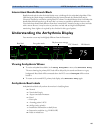
6 ECG, Arrhythmia, and ST Monitoring ECG Safety Information
106
WARNING Defibrillation and Electrosurgery: Do not touch the patient, or table, or instruments, during
defibrillation.
After defibrillation, the screen display recovers within 10 seconds if the correct electrodes are used and
applied in accordance with the manufacturers instructions.
According to AAMI specifications the peak of the synchronized defibrillator discharge should be
delivered within 60 ms of the peak of the R wave. The signal at the ECG output on the IntelliVue
patient monitors is delayed by a maximum of 30 ms. Your biomedical engineer should verify that your
ECG/Defibrillator combination does not exceed the recommended maximum delay of 60 ms.
When using electrosurgical (ES) equipment, never place ECG electrodes near to the grounding plate of
the ES device, as this can cause a lot of interference on the ECG signal.
General: When you are connecting the electrodes or the patient cable, make sure that the connectors
never come into contact with other conductive parts, or with earth. In particular, make sure that all of
the ECG electrodes are attached to the patient, to prevent them from contacting conductive parts or
earth.
During surgery: Use the appropriate orange electrode ECG safety cable for measuring ECG in the
operating room. These cables have extra circuitry to protect the patient from burns during cautery, and
they decrease electrical interference. These cables cannot be used for measuring respiration.
Pacemaker failure: During complete heart block or pacemaker failure to pace/capture, tall P-waves
(greater than 1/5 of the average R-wave height) may be erroneously counted by the monitor, resulting
in missed detection of cardiac arrest.
Patients exhibiting intrinsic rhythm: When monitoring paced patients who exhibit only intrinsic
rhythm, the monitor may erroneously count pace pulses as QRS complexes when the algorithm first
encounters them, resulting in missed detection of cardiac arrest.
The risk of missing cardiac arrest may be reduced by monitoring these patients with low heart rate limit
at or slightly above the basic/demand pacemaker rate. A low heart rate alarm alerts you when the
patient’s heart rate drops to a level where pacing is needed. Proper detection and classification of the
paced rhythm can then be determined.
Filtered ECG signal from external instruments: Instruments such as defibrillators or telemetry units
produce a filtered ECG signal. When this signal is used as an input to the bedside monitor, it is filtered
again. If this twice-filtered signal is passed to the arrhythmia algorithm, it may cause the algorithm to
fail to detect pace pulses, pacemaker non-capture, or asystole, thus compromising paced patient
monitoring performance.
External pacing electrodes: When a pacemaker with external pacing electrodes is being used on a
patient, arrhythmia monitoring is severely compromised due to the high energy level in the pacer pulse.
This may result in the arrhythmia algorithm’s failure to detect pacemaker noncapture or asystole.
Fusion beat pacemakers: Pacemakers that create fusion beats (pace pulse on top of the QRS complex)
cannot be detected by the monitor’s QRS detector.
Rate adaptive pacemakers: Implanted pacemakers which can adapt to the Minute Volume may
occasionally react on the Impedance measurement used by patient monitors for the determination of
the Resp value and execute pacing with the maximum programmed rate. Switching off the Resp
measurement can prevent this.


















